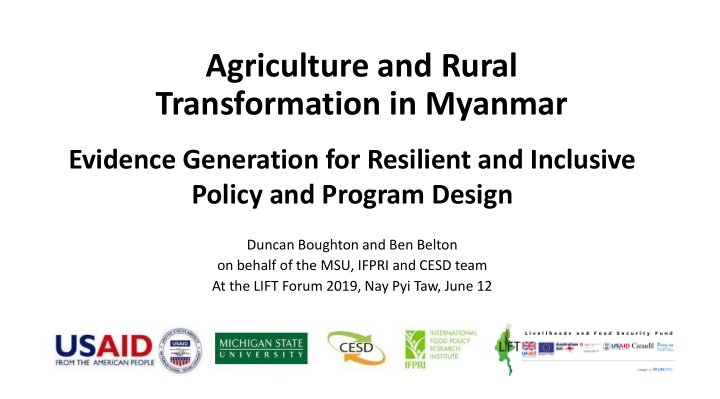



Agriculture and Rural Transformation in Myanmar Evidence Generation for Resilient and Inclusive Policy and Program Design Duncan Boughton and Ben Belton on behalf of the MSU, IFPRI and CESD team At the LIFT Forum 2019, Nay Pyi Taw, June 12
Outli line Backwards look: • What have we learned about agricultural and rural transformation? • Summary of project contributions to the evidence base • Unpack the evidence of an important LIFT contribution: example of mechanization Forward look: • Future challenges for resilient and inclusive rural transformation • Implications for rural development policy and investment strategy • Types of evidence and analysis helpful to support strategy implementation going forward 2
Key Fin indings on Ag and Rural Transformation (1) Transformation of agriculture and the rural non-farm economy (NFE) has been rapid over the past five years: • Major improvements in road infrastructure, schools, communications and electricity • Surge in domestic and international migration out of rural areas • Rapid increases in real rural wages • Extremely rapid mechanization • Increased access to credit and lower interest rates on informal loans • Dynamic value chains (e.g., aquaculture, poultry, maize, fruit) • Expansion and diversification of the NFE (e.g., transport, retail, services) 3
Key Fin indings on Ag and Rural Transformation (2) Transformation is uneven: • Uneven spatially: hilly/remote areas (high transport costs) • Uneven across households (resource endowments) • Persistent wage gap between male and female workers • Persistent yield gaps and low profitability for most pulses, oilseeds, and paddy (staple crops are not a pathway out of poverty for smallholders) • High price instability for pulses, maize and rice due to narrow and unpredictable export markets • Rural SME’s employ few workers 4
Project Contrib ibutio ions to the Evid idence Base 4 regional rural livelihood studies • 7,300 households • 700 communities 8 value chain enterprise studies • Aquaculture • Rubber • Pulses • Oilseeds • Maize • Livestock • Mechanization • Variety Adoption and Seed Demand 5
Unpacking a LIF IFT success story ry: drivers and patterns of mechanization • Demand side drivers • Supply side drivers • LIFT finance guarantees have a catalytic effect on commercial bank credit for rental service SMEs • Rapid, smallholder inclusive outcomes 6
Driv ivers: Rapid id inc increases in in outmig igratio ion driv ive inc increases in in rea eal rural l wage rates whic ich driv ive inc increases in in demand for mechanis isatio ion (MMK/day) 4500 +15 MON DRY ZONE 4000 +20 % 100.0% International International % 3500 80.0% Domestic Domestic 3000 60.0% 2500 2000 40.0% 1500 20.0% 1000 0.0% 500 0 2012 2014 2016 7
Dri river: LI LIFT ri risk shari ring guara rantees encourage commercial banks to lend to rental businesses like this one… 8
In Increased re rental service pro rovision enables more re rapid access to farm machinery…. HH using rented machine HH using own machine % OF HH USING MACHINE 100 80 60 40 20 - 2007 2012 2017 2007 2012 2017 2007 2012 2017 2 WT 4 WT Machinery in land preparation in land preparation in threshing Share of farm HH using own or rented machines in land preparation and threshing (Shan) 9
Rental services allow inclusive access to machinery…. 90% T1 T2 T3 80% 70% 60% 50% 40% 30% 20% 10% 0% Any machine 2WT 4WT Combine Thresher Share of HH using machinery by landholding tercile and machine type (Dry Zone) 10
… and stimulate faster growth in the number and coverage of machinery supply businesses. Number of agricultural machinery supply businesses by township, 1994-2018 (Delta & Dry Zone Enterprise surveys) 11
Future challenges for resil ilient and in inclusive rural transformation • Outmigration will continue (welfare outcomes related to skills). • Mechanization will continue (increased scope of operations). • Rural incomes correlated with proximity to urban centers (risk of hinterlands left behind). • Increased specialization in agriculture (more capital and knowledge intensive) in response to urban and export demand. • Sustainable soil and water management strategies. • Increased pest and disease challenges due to specialization, climate change and cross border epidemics. 12
Some im impli lications for rural development poli licy and strategy • Stronger and more effective agricultural research, education and extension is essential to realize agricultural growth potential and reduce risks for producers and consumers. • A more enabling environment needed for expanded smallholder engagement in high margin enterprises (access to capital, knowledge, specialized inputs and services, land use flexibility). • A more enabling environment for women’s engagement in agriculture and the rural economy in ways that strengthen family cohesion. • Improved market outlook analysis and trade management to reduce price shocks. • Regional approach to agricultural development and nutrition strategies with closer collaboration between union and regional governments, and between public and private sectors. 13
Looking forw rward: evid idence generation to support strategy im implementation • Rural economies, and agriculture, will continue to change very rapidly in the coming decade. • Different regions will experience different opportunities and challenges. • Even within the same region, households and individuals have widely different capacities and needs in order to thrive. • Regular, regionally representative, household and enterprise surveys and analysis to enable policies and investment strategy to adapt. • More qualitative research on how interventions affect intra-household welfare, especially for women and children. • Requires stronger government “buy in” and capacity to utilize analysis. 14
A fin inal word of thanks to an outstanding team Congratulations to 8 team members who received competitive scholarships for graduate training - 3 at PHD level 15
Recommend
More recommend